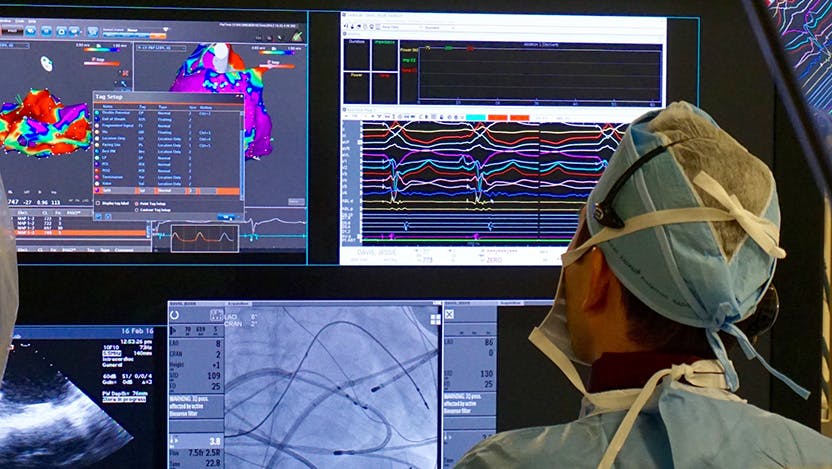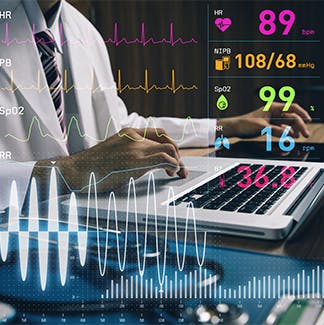Atrial fibrillation vs. atrial flutter

With the questions we routinely see regarding understanding the different between atrial flutter and atrial fibrillation (AFib), I wanted to provide answers about how patients can identify an arrhythmia, when to seek a specialist and what treatments are available.
What is atrial flutter?
Atrial flutter results from a 'short-circuiting' of the normal impulse in a loop that revolves around the top right chamber of the heart in most patients. Fortunately, this type of rhythm—called typical atrial flutter—is actually curable. It runs in a predictable loop in the atrium, like a racetrack. The racetrack can be interrupted and blocked using catheter ablation.
How is atrial flutter different from atrial fibrillation?
In contrast to atrial flutter, atrial fibrillation is a more chaotic rhythm that does not follow one set loop. When the heart's chamber fibrillates, it quivers or shakes, rather than contracting. This may produce similar symptoms to atrial flutter because of how fast the heart beats.
Many patients have both conditions as one rhythm can transition into another. In atrial flutter, the heart's top chamber does not empty effectively and is out of sync with the contraction of the main pumping chamber of the heart. The presence of this rapid rhythm, which typically conducts every two to three times down the lower chamber, increases the risk for developing a blood clot in the heart and consequently increases a patient's risk for stroke.
Importantly, both atrial flutter and atrial fibrillation may be associated with the risk for stroke, and use of blood thinners help reduce these risks.
Many patients have both conditions as one rhythm can transition into another. In atrial flutter, the heart's top chamber does not empty effectively and is out of sync with the contraction of the main pumping chamber of the heart. The presence of this rapid rhythm, which typically conducts every two to three times down the lower chamber, increases the risk for developing a blood clot in the heart and consequently increases a patient's risk for stroke.
Importantly, both atrial flutter and atrial fibrillation may be associated with the risk for stroke, and use of blood thinners help reduce these risks.
How are atrial flutters treated?
Some patients are asymptomatic, while others experience palpitations, lightheadedness or even heart failure. Patients are typically treated with either medications that slow the transmission of the short circuit to the lower chambers or with an approach called rhythm control. In rhythm control, our goal is to restore and maintain the heart’s normal rhythm. This may involve the use of catheter ablation, which is a minimally invasive surgery directed at the flow of electricity in the heart, or the use of rhythm controlling medications.
Are atrial flutters curable?
Catheter ablation cures more than 90% of cases of typical flutter. During the procedure, thin electrodes are threaded up the large veins in the leg and positioned in the heart. Through these electrodes, physicians stimulate the heart and induce abnormal heart rhythms. Once we are able to locate the abnormal electrical tissue responsible for these arrhythmias, we deliver radiofrequency energy to make a controlled ‘burn’ inside the heart which eliminates the arrhythmia.
The creation of a line by radiofrequency cauterization interrupts and unhinges the 'racetrack loop,' which permanently blocks the reentrant arrhythmia of flutter. This arrhythmia is one of the best understood mechanisms in human electrophysiology.
The creation of a line by radiofrequency cauterization interrupts and unhinges the 'racetrack loop,' which permanently blocks the reentrant arrhythmia of flutter. This arrhythmia is one of the best understood mechanisms in human electrophysiology.
How is treating AFib similar to atrial flutter?
Similar to atrial flutter, treatment options for AFib include anticoagulation (blood thinners) and controlling the arrhythmia with medication or catheter ablation therapy.
Ablation is also effective in 60% to 70% of AFib patients. We give patients the analogy that atrial fibrillation is like a pest problem in your home. We come in and we do a treatment and we can control the cases but frequently it requires multiple treatments. We start with the initial set of treatments and then we get more aggressive as the pest problem declares itself to be more and more stubborn. Current research seeks to understand the mechanisms of atrial fibrillation, which appear to come from multiple areas at the same time.
At the University of Chicago Medicine, our team uses special catheters that allow them to know how much force is being applied onto the tissue, which has been shown to improve the success rate for the procedure. We are one of only a handful of centers in the United States that provide a complete suite of approaches to AFib, including hybrid procedures with epicardial robotic surgery in conjunction with endocardial ablation. We also are able to utilize the most advanced mapping systems.
Ablation is also effective in 60% to 70% of AFib patients. We give patients the analogy that atrial fibrillation is like a pest problem in your home. We come in and we do a treatment and we can control the cases but frequently it requires multiple treatments. We start with the initial set of treatments and then we get more aggressive as the pest problem declares itself to be more and more stubborn. Current research seeks to understand the mechanisms of atrial fibrillation, which appear to come from multiple areas at the same time.
At the University of Chicago Medicine, our team uses special catheters that allow them to know how much force is being applied onto the tissue, which has been shown to improve the success rate for the procedure. We are one of only a handful of centers in the United States that provide a complete suite of approaches to AFib, including hybrid procedures with epicardial robotic surgery in conjunction with endocardial ablation. We also are able to utilize the most advanced mapping systems.
Why choose UChicago Medicine for arrhythmia treatment?
One, the true collaborative spirit of our team. When you come and see any one of us, you get a whole team approach. Two, we really embrace innovation. We are looking on a daily basis to find new techniques for problems that cannot be solved with traditional methods. And three, as a major academic center, we will often get the earliest release of the latest technologies, and we serve as the national and global site for multiple randomized clinical studies.
Patients also have access to a state-of-the-art arrhythmia lab, which is dedicated solely to the treatment of arrhythmias.
Patients also have access to a state-of-the-art arrhythmia lab, which is dedicated solely to the treatment of arrhythmias.

Gaurav Upadhyay, MD
An expert in cardiac rhythm devices, Gaurav A. Upadhyay, MD, cares for patients with arrhythmia, fainting (syncope) and heart failure. Dr. Upadhyay focuses on innovative electrical therapies in heart disease, including cardiac resynchronization therapy (CRT), MRI-compatible pacemakers, subcutaneous defibrillators and catheter ablation.
Learn more about Dr. Upadhyay
Arrhythmia Care
At the University of Chicago Medicine Center for Arrhythmia Care, we work with each patient to deliver high-quality, personalized care, whether you are seeking a first opinion for your condition or turning to us as a last resort.
Discover more about our arrhythmia program